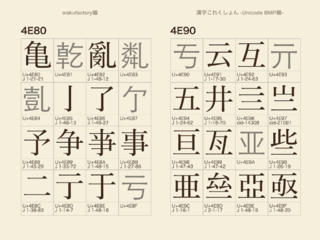了
了 (了, X4E86) is Unicode character number 20102, KanjiLiberal.
Also, an attempt to access KanjiConfudal 了 (了, XF9BA) redirects here.
了 can be pronounced as "ryou" and refer to termination of something.
ァ, ア, 了, 了
The four Unicode characters look similar:
Even a native Japanese speaker, looking at characters
ァ, ア, 了, 了
usually cannot guess,
which of them is X30A1,
which of them is X30A2,
which of them is X4E86 and
which of them is XF9BA.
In order to avoid the confusion,
some programming is necessary.
Encoding of the four similar characters
ァ, X30A1 and
ア, X30A2 and
了, X4E86 and
了, XF9BA
can be revealed with program ud.t.
For the execution, file uni.t also should be loaded.
Then command
php ud.t 30A1 30A2 4E86 F9BA
makes the following output:
K= 5
30A1 12449 X30A1 ァ
Unicode character number 12449 id est, X30A1
Picture: ァ ; uses 3 bytes. These bytes are:
XE3 X82 XA1 in the hexadecimal representation and
227 130 161 in the decimal representation
30A2 12450 X30A2 ア
Unicode character number 12450 id est, X30A2
Picture: ア ; uses 3 bytes. These bytes are:
XE3 X82 XA2 in the hexadecimal representation and
227 130 162 in the decimal representation
4E86 20102 X4E86 了
Unicode character number 20102 id est, X4E86
Picture: 了 ; uses 3 bytes. These bytes are:
XE4 XBA X86 in the hexadecimal representation and
228 186 134 in the decimal representation
F9BA 63930 XF9BA 了
Unicode character number 63930 id est, XF9BA
Picture: 了 ; uses 3 bytes. These bytes are:
XEF XA6 XBA in the hexadecimal representation and
239 166 186 in the decimal representation
Not only humans, but also some software confuse characters
了 (KanjiLiberal) and 了 (KanjiConfudal), silently replace the last of them to the first. In particular, at the copypasting of the previous paragraph here, the KanjiConfudal 了 has been automatically substituted to KanjiLiberal 了 without any warning.
Semantic
了 may refer to graduation, termination, copletion, understanding, finishing of something. [2]
Phonetic
了 can be pronounced as "ryou", リョウ. [2]
Other pronunciations depend on semantics [2][3][4]:
おわる ("owaru")
おえる ("oery")
さとる ("satoru")
On the base of dictionaries mentioned, it is difficult to suggest any efficient mechanism of relation between the sound and the narrow specific meaning; so, the interpretation is a custom rather than a scientific concept.
Graphic
了 (X4E86) appears as graphical element of a little bit more complicated KanjiRadical ⼦ (X2F26) and the similar KanjiLiberal 子 (X5B50).
Pictures of ⼦ and 子 look as overlapping of 了 with horizontal bar, for example, ⼀ (X2F00).
References
- ↑ http://wakufactory.jp/densho/kankore/kankore_bmp.html UnicodeのBMP面にある漢字28,001文字をひたすら並べたEPUBファイルです。漢字の表示は、リーダのフォントに依存します。 Unicodeのコードポイントと、JISの面区点コード、Adobe-Japan 1のCIDコードも併記しました。EPUBリーダの検索機能で、文字コードDBとして使うこともできます。 (2021)
- ↑ 2.0 2.1 2.2 https://mojinavi.com/d/u4e86 了とは、ついに/あきらか/さとる/おわる/おえるなどの意味をもつ漢字。2画の画数をもち、亅部に分類される。日本では常用漢字に定められており、中学校卒業レベルの漢字とされる。// 字体 了 読み 音読み リョウ
- ↑ https://www.kanjipedia.jp/kanji/0007150500 音 リョウ 訓 外おわる・しまう・さとる
- ↑ https://kotobank.jp/word/%E4%BA%86-676325 了(読み)リョウ デジタル大辞泉「了」の解説 りょう【了】[漢字項目] [常用漢字] [音]リョウ(レウ)(呉)(漢) [訓]おわる おえる さとる 1 終わりになる。けりがつく。…してしまう。「完了・議了・校了・修了・終了・投了・読了・満了・未了・魅了」 2 はっきりとさとる。「了悟・了得」 3 明らか。「了然・了了/明了」 4 (「諒」の代用字)もっともだと思う。「了解・了察・了承」 [名のり]あき・あきら・お・さだ・さと・すみ・のり [難読]和了(ホーラ)・完了(ワンラ) りょう〔レウ〕【了】 終わること。論文や小説などの終わりに用いる。「この項、了」
Keywords
du.t, ud.t, Japanese, Kanji, KanjiConfudal, KanjiLiberal, KanjiRadical, PHP, Unicode, Utf8, X4E86, XF9BA, 了, 了
